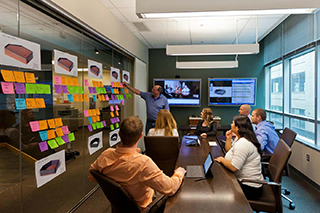|
Subscribe / Renew |
|
|
Contact Us |
|
| ► Subscribe to our Free Weekly Newsletter | |
| home | Welcome, sign in or click here to subscribe. | login |
Construction
| |
 |
May 2, 2013
‘Big Room’ streamlines collaboration, communication
Howard S. Wright

Peyovich
|
As new technology is changing the way construction teams talk to each other — from the superintendent who identifies clashes on drawings by pointing, to the building information modeling specialist who is trained on sophisticated 3-D software — it’s becoming increasingly important to find ways to communicate across technology boundaries.
Our ability to communicate with each other at all levels of expertise is one of the most critical aspects of our business. Knowing this, we challenged some of our most innovative and forward-thinking experts to develop a solution that would set new standards for a collaborative work environment in the construction industry.
Our team developed that solution and we believe the future of construction is now up and running at Howard S. Wright. We recently opened what we call our Big Room—Collaboration Suite in our downtown Seattle office.
Inside this 240-square-foot conference room is a powerhouse of modern technology that is going to change how project teams interact by providing the technical tools that will help us become more integrated, and level the technology playing field. Every element in the Big Room is set up so that clients, designers, consultants and construction teams of all levels of technical expertise can collaborate more effectively.
The Big Room becomes the hub for virtual design and planning of a construction project, and can also be used for web conferencing, building clash detection, project startups, proposal development and interview preparation.
Big Room features
Inside the Big Room are two 60-inch touchscreens that display intuitive icons and are equipped with software that enables the virtual design and construction of a building. The touchscreens have built-in high-definition cameras, microphones and speakers. They run a digital interactive whiteboard program that allows the presenter to write and save notes directly on the screen.
The Big Room is also equipped with a wireless tablet for remote sharing and wireless keyboards. With the wireless features, presenters are able to walk around for a greater impact and can point to other visual aids in the room. Additionally, the conference table can be separated into six workstations, allowing individual tasking in a team setting.
The entire north wall is coated with dry-erase paint so that team members can write on it, just like you would a large whiteboard.
The east wall is all glass and an ideal surface for use in pull-planning sessions, an innovative method of planning that creates buy-in and ownership of task scheduling for each member of the team. The process involves the use of notes posted to the glass wall to create a visually managed avenue for people to identify constraints, build communication as a team and improve project flow.
Touchscreen dashboard
One of the most exciting and innovative elements in the Big Room is the new user-friendly dashboard that is displayed on the home page of both 60-inch monitors. The dashboard allows the user to interface with all project files at the touch of a button. This technology is also being implemented on our plan room computers and in the field on tablets and portable field workstations. Now all project data can be synched from the job site to the main office, so everyone has the most up-to-date information.
The dashboard is designed to be as simple to use as any smartphone or touchscreen device. The icons are intuitive and link to everything from digital drawings, project schedules and safety plans, to weather reports. In the field, craft workers can quickly access the most current project data right from their workstation.
The single most important aspect of this tool is the ability to have easy, instant access to anything referenced on a document that is being viewed by a user. The home page design makes it simple to navigate so that any questions can immediately be answered by touching the appropriate link.
Big Room in action
The Big Room is new, but project teams are already reaping the benefits. The technology, touch capability and room adaptability has made an impact on the effectiveness of everything from interview practices to design meetings to planning sessions.
Rather than staying seated, collaborators are walking, talking and using their tablets to make points as images show up on the monitor. They are pointing to the monitor screen, touching icons and directly accessing documents that are being discussed. They are writing on the digitally interactive whiteboard in cursive, where it’s being converted to text and then emailed to team members in a matter of seconds. They are sticking notes up on the glass walls, writing on the whiteboards and sharing that information with users who are connected via video conferencing.
Tables are being pulled apart and put back together again, depending on the needs of the group in the Big Room. Plans are being displayed digitally as collaborators inside the room, as well as remotely, are viewing them all at the same time. When changes are made, everyone has the most current information instantly.
The Big Room is providing the tools needed to save money for clients and offer sustainable solutions that help the environment. The success of the design and function of the Big Room is being replicated in all of our West Coast offices.
The forward-thinking tools and design of the Big Room are setting the bar higher for collaborative work environments, which ultimately benefits our clients with more effective communication and efficient project delivery.
Dan Peyovich is Washington Division President of Howard S. Wright, a Balfour Beatty company.
Other Stories:
- Safety's role in the ‘new normal’ of construction
- Health Care
- Commercial Construction
- Survey: Andersen Construction
- Demolition
- Specialty Construction (merit award)
- Survey: S.D. Deacon
- Survey: Lease Crutcher Lewis
- Survey: Skanska USA
- Survey: Express Construction Co.
- Survey: PCL Construction Services
- Electrical & Communications
- Mechanical Construction
- Mixed-Use Construction
- Technology moves construction projects off the paper trail
- Going modular? Think of the factory as a big subcontractor
- Sharp equipment managers use decision points
- Sick leave, pot laws leave employers feeling queasy
- Making sense of construction cost audits
- Is your insurance broker a claims advocate?
- Avoid the pitfalls of transition planning
- Eagle of Excellence Award • Tenant Improvement/Renovation
- Eagle of Merit Award • Specialty Construction
- Institutional
- Survey: Rider Levett Bucknall



